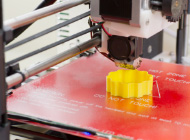
Vat polymerization is one of the printing processes used in 3D printing. In this process, resin material is cured by a light source. While the material is exposed to a light source, the build plate moves the object downward to create each layer.
One of the printing technologies that is based on vat polymerization is DLP. This 3D printing technology is similar to SLA 3D printing. It is often called its “sister technology”. Both make use of liquid photopolymer resin. However, instead of using a UV laser to cure the resin, a light source (or a projector) is used.
To understand DLP 3D printing properly, here is a blog post about the 5 facts you need to know about DLP 3D printing. Read on here.
-
Brief History of DLP
In 1987, Larry Hornbeck of Texas Instruments created the technology for DLP. This technology uses digital micromirrors that are laid out on a semiconductor chip called Digital Micromirror Device (DMD). Each of these micromirrors represents a pixel in the image for display.
DLP is used in several applications including movie projectors, mobile phones and 3D printing. In 1981, Hideo Kodama of Nagoya Municipal Industrial Research made the first published account of a 3D printed model using this technology.
-
What is DLP printing
DLP or Digital Light Processing is a 3D printing technology in the type of vat polymerization. Vat polymerization is a process that uses liquid photopolymer resin. This resin is cured (solidified) under a light source or projector to form a new object.
The light source of a DLP 3D printer should have a digital micromirror device (DMD). DMD is considered as the “heart” of every DLP chipset. It is composed of hundreds of thousands of small micromirrors. It directs the light and creates the pattern of layers directly to the bottom of the resin tank.
-
How does DLP 3D printer work?
DLP uses a specially designed digital light projector screen as a light source. Because of this projector screen, DLP generally prints faster compared to SLA 3D printing.
Once the 3D design is sent to the DLP printer, a vat of liquid polymer is exposed to light from a projector. The light source should be under safelight conditions. After that, the projector displays the image of the 3D model on the liquid polymer.
As the build plate moves down, the liquid polymer is exposed to light. Once it is exposed to light, the liquid polymer hardens. This process is repeated until the object is formed.
In DLP, the 2D image that is projected is composed of pixels. Once it is translated into three dimensions, they become voxels.
DLP renders images using rectangular voxels. When printed, there is an effect of vertical voxel lines. The curved edges on the 3D parts may also appear more stepped.
-
Materials used for DLP 3D printing
DLP printing uses photopolymer resin to create 3D parts. Resin comes in different types. These include standard resin, grey resin and transparent resin.
Aside from resin, metal is also used for DLP printing. During this process, instead of using resin, metal powder and a small amount of binder are used. Metal DLP 3D printing is ideal for printing objects that require highly detailed designs. It can feature details as small as 0.3mm. It can also print layers that can be as thin as 0.1mm.
-
Why use DLP 3D printing
Some designers and engineers use DLP because it produces highly accurate parts. Moreover, DLP produces 3D parts with excellent resolution.
Unlike SLA, DLP only requires a shallow vat of resin to facilitate its process. Thus, it results in less waste on its materials. It also lowers its running costs.
DLP also prints 3D parts significantly fast. This is because it allows for curing the whole surface of a layer all at once. Post-curing is also less required. As an illustration, a 4-hour long print with an SLA printer can only take 30 minutes with a DLP printer for the same 3D file.
Conclusion
DLP 3D printing is a printing technology based on vat polymerization. It has a similar process to SLA 3D printing. It uses liquid photopolymer resin and light source to produce 3D parts.
DLP 3D printing may not be as popular as other 3D printing technology like FDM. But it is chosen by some designers and engineers because it can generate highly detailed 3D parts.
For your 3D printing projects, you can ask the nearest 3D printing service company to assist you. They can also provide 3D printing services such as 3D printing, industrial 3D printing, custom 3D printing, 3D design modelling and many more.







